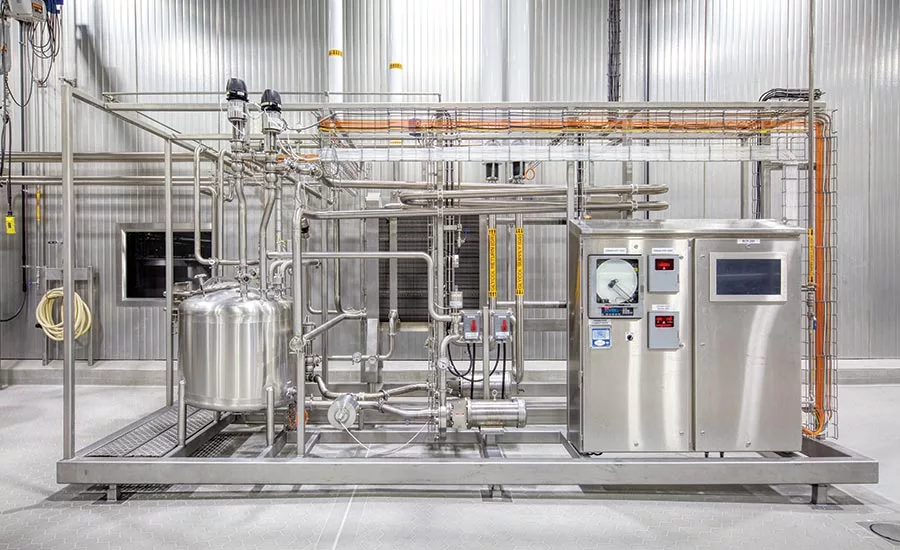Crisis preparedness
What food and beverage processors need to know about a disaster recovery plan

Food and beverage processors are good at writing and executing detailed action plans for all sorts of topics—food safety, preventive controls, food defense and emergency preparedness. With that last subject on everyone’s minds these days, experts suggest that manufacturers draw on the momentum from their COVID-19 response to fortify planning for whatever comes next.
Photo courtesy of Sentry Insurance

Deep supply chain analytics help processors make adjustments with speed and confidence—during a crisis or not.
Photo courtesy of Infor

Sentry Insurance tries to learn about every challenge that a processor faces to help figure out not only what coverage is needed, but also how the carrier’s decades of food industry experience can help reduce the manufacturer’s risks.
Photo courtesy of Sentry Insurance

Your management team will need to prepare a communications plan for customers and employees. Identifying a communications leader ahead of time can be effective.
Photo courtesy of Sentry Insurance

The Shambaugh & Son engineering team designed a solution to anchor numerous tanks, pieces of equipment and skids to the vitrified tile floors at the Valley Milk plant. Builders imbedded stainless steel plates into the concrete slabs to provide a surface for seal-welding skid and equipment feet.
Photo courtesy of Shambaugh & Son
Every food and beverage manufacturing operation now has important information about its strengths and weaknesses in a crisis.
Has your company’s emergency preparedness plan helped reduce some damage to your business while your operation and your people weather the COVID-19 outbreak? Experts who work with food processors to prepare for disasters or disruptions say the businesses typically have strong plans in writing for how to react to everything from wildfires and hurricanes to plant fires and worker deaths. Now health scares have new prominence in that planning, which is going through the ultimate test.
What parts of your planning fell short in the outbreak and likely left you scrambling to react to shortages of supplies, workers or transportation? What worked well that you should document for the future?
Let’s explore some ways to strengthen your facilities’ emergency planning and act decisively when the next crisis happens—or even to help as you adapt during the remainder of this outbreak.
“As some companies are discovering due to COVID-19, a strong crisis management plan is important to their organization,” says Nick Naas, senior loss control consultant, Sentry Insurance, which has insured food and beverage companies for decades.
Crisis management plans should consider these questions, he says:
- Does your plan clearly outline your objective? For example, is your objective to protect your employees, customers or both?
- How will your supply chain continue operating during a crisis? Review supplies to determine if you have a backup.
- Do you know which people have to work on-site and which people can work remotely?
- What method of communication will your company use to connect with employees, suppliers, and customers? Do you have a quick communication plan via email?
- If appropriate, how will your company handle media relations? Who are spokespeople for the company? What is the overarching message you’ll deliver to the media?
- Are you working with an insurer that you find trustworthy? Will your carrier address your claim in a timely fashion? “You don’t want to be questioning whether your current carrier is fighting for you or not.”
“All these matters and more should be considered and ready for rollout if a crisis occurs,” Naas says.
The Occupational Safety and Health Administration provides an emergency preparedness guide that would be helpful to review—covering a variety of emergencies including bomb threats, chemical agents, disease outbreaks and all varieties of natural disasters and weather dangers.
Looking for quick answers on food safety topics?
Try Ask FSM, our new smart AI search tool.
Ask FSM →
A safety culture
Naas says a strong insurer can provide resources beyond coverage itself to food and beverage processors before a disaster, helping them limit losses and reduce risk. Sentry’s safety consultants help processors with their efforts to build a safety culture, developing a customized service plan, formally or informally. “Whether it’s training offerings, jobsite visits for companies, or a program review, we’re available to close the gaps we identify during risk surveys.”
The company’s safety team has been on-site at many food processing plants over the years, giving those consultants an understanding of the industry’s unique requirements to keep food safe throughout the supply chain.
“With that, we’ve seen what works, what doesn’t work, common pitfalls, uncommon pitfalls, and everything in between,” Naas says.
Sentry offers risk survey services, loss control consulting, training resources and program documentation reviews.
Building for the worst
When choosing a facility site, risks associated with natural disasters, including flooding and earthquakes, typically can be mitigated through design and construction, says Dan Ritzert, senior vice president, mechanical and process, Shambaugh & Son L.P., an EMCOR Group Inc. subsidiary. Proximity to processors’ input materials and finished goods destination, operating costs, and availability of utilities and qualified manpower are the primary site selection drivers.
The design-build firm’s processing customers that already operate facilities in a disaster-prone area are very knowledgeable about codes and requirements in their areas, he said. They’re not surprised by special design and construction considerations like seismic restraints during work on facilities.
Shambaugh’s experience designing and constructing processing plants across the country helps when processors move into these areas.
Plus, Shambaugh is one of the top fire protection contractors in the industry. While fire protection is often a small piece of an overall project, Shambaugh’s experience across the U.S. brings valuable design and installation perspective, Ritzert says.
That expertise helps when working with food manufacturers that commonly must reduce risk of dust explosion or other flammables. Shambaugh works with many processing facilities that have cooler/freezer spaces, explosive/combustible environments (i.e., powders), flammables (i.e., alcohol-based flavors), clean spaces subject to foaming/sanitizing, and/or clean room spaces (i.e., IT rooms).
Although Shambaugh routinely designs and installs fire protection systems for this varied cross-section of environments, many engineers or contractors do not have the same depth of experience, Ritzert says.
With COVID-19, we’re in the infant stages of understanding how the health threat will impact construction projects or the normal business of operating a processing plant in the U.S., he notes.
Two standout plants
Shambaugh, which has rebuilt two snack foods plants after fires, shares a couple examples of how buildings are designed to mitigate natural disasters and weather troubles.
Valley Milk’s seismic requirements: While designing and building Valley Milk’s powder processing facility, Food Engineering’s 2019 Plant of the Year, Shambaugh strictly followed California seismic regulations, says Patrick Cole, program manager, national design-build.
The facility was constructed as four buildings with 4-inch gaps between each building. All pipe line transitions between buildings required flexible joints, ceilings had intensive support structures, and all equipment had engineered, welded anchoring.
The Shambaugh engineering team provided a clean solution for anchoring numerous tanks, pieces of equipment and skids to the vitrified tile floors to accommodate seismic design requirements, Cole explains. This innovative solution imbedded stainless steel plates into the concrete slabs, so that each plate would be proud of the tile to avoid ponding water, but provide a surface that skid/equipment feet could be seal-welded to the floor.
Bob Keplinger, vice president, national design-build operations for Shambaugh, says the company has found seismic requirements in the building code are fairly standard, but ensuring process equipment is ordered and constructed to meet local seismic codes and designed to be anchored to meet codes—especially the anchoring piece—can be challenging.
When working with seismic design engineers for piping in process spaces, sway bracing, etc. for pipe and racks isn’t readily available in stainless assemblies that consider clean design, so experience in working with seismic engineers to put together piping plans that incorporate seismic with clean design is key, he says.
DFA plant’s notification system: During Shambaugh’s work on the Dairy Farmers of America’s southwest Kansas plant, FE’s 2018 Sustainable Plant of the Year, the unique susceptibility to storms required the design and installation of a mass notification system, says Dennis Whipple, manager, electrical design-build.
The notification system was comprised of a fire alarm system, used for storm warning with automatic voice control where prerecorded messages alert staff to quickly proceed to predetermined safe zones built into the design and construction of the facility.
After the disaster
Each disaster has different circumstances; therefore, it’s important that the crisis team has addressed planning questions beforehand, says Naas of Sentry Insurance.
The crucial first step is ensuring the health and safety of employees, he notes. If there’s an immediate concern, the management team must address it.
In a time of great need, employees will look to the management team for leadership and direction, he says. This is a time for the management team to map out responses to employees and customers.
During a crisis, few people know the full result of the incident, Naas points out. The management team, to the best of its ability, should outline a timeline for employees and customers to provide a level of reassurance without overstating or overpromising the circumstances.
Preparing a communications leader who shares the plan broadly can prove to be very effective during a disaster, he says. “There is also a great deal of strength that can be harnessed from your team. A crisis is a time for people to come together.”
Fixing the damage
When a facility is damaged, a quick response from the insurer is needed as the manufacturer weighs whether to rebuild. “The moment it’s deemed safe to survey after damage, our goal is to be on-site to help our customers through the claims process quickly,” Naas says. “The more efficiently we can assess the situation, the sooner we can evaluate any financial reimbursements required to get their food processing business running smoothly again.”
Sentry has had cases where team members surveyed damages on a Sunday and released a check to the business that same day so it could rent a temporary facility, he says. Sentry also offers coverages that help businesses restart their services faster.
Supply chain disruption
Along with protecting your buildings and your people, you’ll need to think through your backup plans to try to keep your supply chain moving when an emergency siphons resources or causes slowdowns.
The COVID-19 outbreak has highlighted supply chains’ fragile nature, says Christine M. Barnhart, Infor Supply Chain Management director.
When this crisis subsides, she says businesses must keep a sense of urgency and not become complacent in taking actions to improve business processes and invest in technology. “Now is the time to start conversations, organize discovery and work to identify and prioritize an improvement strategy for your business.”
She highlights some supply chain problems producers have experienced:
- delays on critical raw materials and components due to various factors, such as national shutdowns or work stoppages offshore; increased demand for limited truck resources; re-allocation of supplier capacity to other products due to critical needs
- strapped internal resources because of self-quarantine and/or the need to stay home with children or other family
“There is a critical need to replan using real-time data and optimize production based on ever-changing dynamics, including retail/customer demand, raw material and component supply/availability and plant workforce capacity,” she says.
Supply chain software tools allow manufactures to model scenarios and optimize responses before disruption strikes.
“As an industry, we need to do a better job of investing not just in the tools, but in the processes and people to perform crisis planning and develop risk mitigation strategies before we are in a global crisis,” Barnhart says.
Manufacturers use Infor CloudSuite Supply Chain Management, a broad collection of planning and execution tools, to make efficient and informed decisions daily with advanced warehousing tools and real-time intelligence and orchestration with trading partners, she explains.
“Supply chains must have broad connectivity, superior planning and advanced execution tools to simultaneously optimize agility, visibility and velocity,” she says.
In one example of the guidance that the tools can provide, Infor Nexus offers a “single source of the truth” with suppliers, giving manufacturers a network view of inventory (planned, in production, in motion and at rest), Barnhart says. Then they can make data-based decisions. “Customers can collaborate with their impacted suppliers, moving orders to alternate facilities, rebalance orders, or even change shipping modes to reduce the impact of supply disruptions.”
“Companies that invest in a full complement of modern digital tools, which include real-time connectivity, intelligence and optimization, not only are armed with the necessary resources to minimize their risk, they can thrive during disruption. They see issues sooner and act faster.”
For more information:
Infor, www.infor.com
Shambaugh & Son, www.shambaugh.com
Sentry Insurance, www.sentry.com









